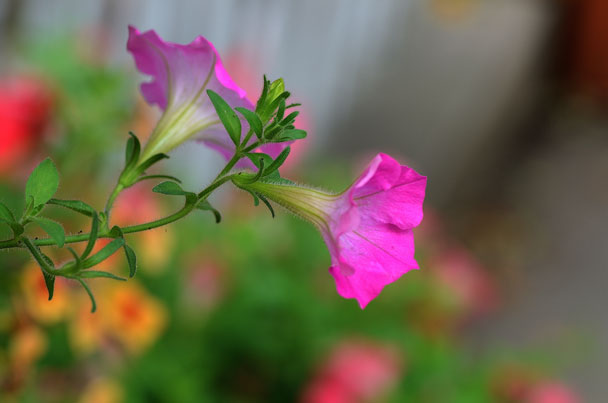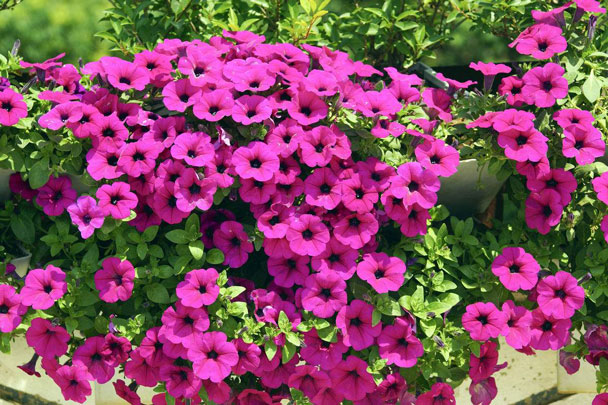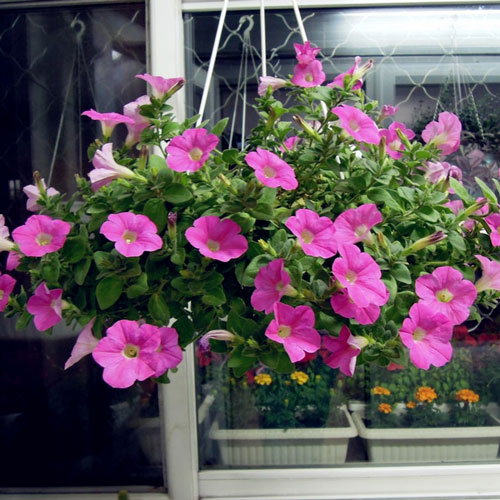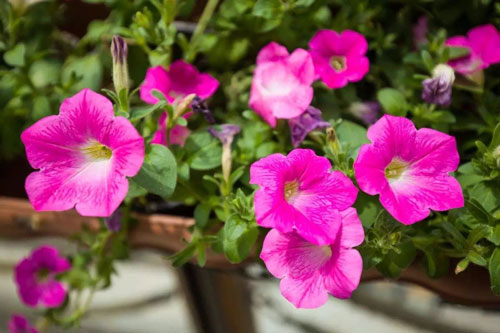How to Care for Petunias
Written by Iris
Oct 28 2021

Petunia is a perennial herb. Petunia is mainly distributed in South America and is now very popular in various countries. Petunia has bright flowers and colorful colors, and its flowering period is from April to frost, so it is also welcomed by many people. The following will introduce how to grow and care for Petunia.
Where to Grow PetuniasHow to grow PetuniasGrow Petunias From SeedGrow Petunias From CuttingsHow to care for PetuniasPetunias Light RequirementsPetunias Soil CarePetunias WateringPetunias Temperature & Humidity CarePetunias Fertilizer CarePetunias Pruning CarePetunias Pests & Diseases CareVarieties of PetuniasMultiflorasGrandiflorasFloribundasMilliflorasTrailing Petunias
Where to Grow Petunias
Petunias need full sun or they will become spindly. They don’t tend to flower well in shade.They are quite versatile, growing well in different types of soil as long as the soil drains well and doesn’t stay wet.
Soil should be moderately fertile to promote the best growth. Amend poor soil with compost prior to planting.
It’s easiest to buy young plants from a nursery that sells petunias in flats. Look for plants that are short and compact, not leggy and not yet blooming—they’ll settle in faster.
If you are going to grow petunias from seed, start the seeds indoors 8 to 10 weeks before your last spring frost date. (See your local frost dates.)
Plant young petunias outdoors after your last spring frost date, but keep a close eye on the weather forecast and protect young plants from late frosts.

How to grow Petunias
Grow Petunias From Seed
It's most common to purchase young petunia plants from a nursery. But it can be worth the challenge to grow petunias from seed, especially if you're trying for a particular variety. Start your seeds at least 10 to 12 weeks before your area's projected last frost date.Spread the tiny seeds on top of a moist seed-starting mix. Gently press them down, but do not bury them as they need light to germinate. Then, cover the container with clear plastic, and put it in a warm spot but out of direct sunlight. You should see seedlings within seven to 10 days. Once they emerge, remove the plastic. When the seedlings have three true leaves, they can be transplanted into their own pots.
Grow Petunias From Cuttings
Here are steps on how to grow Petunias from cuttings.- Prepare pots of soil
Choose Petunia to take cuttings from
This is one of the petunias I will take cuttings from today. I bought this one in a 4 pack from Wal-Mart for $3. I bought these in early April and potted them up to grow on so they would be large enough to take cuttings from.
- Choose stem to cut
The longest stem on this petunia is the one with the big flower blooming. I hate to cut it off when it is so pretty but oh well.
Follow it down as far as you can and find a spot right below a leaf node.
- Take your Cutting
- Remove leaves from petunia cutting
You can pinch them off with your thumbnail or use a sharp knife to sever the leaves from the stem.
It looks pretty sad without all the lovely leaves and flower but soon this little cutting will be sprouting new growth and then later more beautiful flowers.

How to care for Petunias
Petunias Light Requirements
Most petunia varieties prefer full sun, meaning at least six hours of direct sunlight on most days. But in the heat of summer, partial shade (especially from strong afternoon sun) will help to keep them refreshed and blooming better.Petunias Soil Care
Petunias prefer a light, fertile soil that provides good drainage. They can tolerate a variety of soil types as long as they are well-draining. Plus, they like a slightly acidic soil pH.Petunias Watering
Like many flowering annuals, petunias don’t like to be dry for long periods. But they also don’t like to sit in soggy soil, which can rot their roots. Plus, too much water can result in leggy plants with a lot of stem but few flowers. In general, weekly watering when you don't have rainfall will be sufficient. However, some spreading varieties and plants grown in containers typically need more frequent watering. Try not to let the soil dry out more than 2 inches down.Petunias Temperature & Humidity Care
The ideal temperatures for petunias are roughly 60 to 75 degrees Fahrenheit during the day and 55 to 65 degrees Fahrenheit at night. They can tolerate temperatures all the way down to about 40 degrees Fahrenheit, but frost and freezing temperatures will damage and ultimately kill the plants. Low to moderate humidity levels are best for these flowers.Petunias Fertilizer Care
Feed petunias at the time of planting with a balanced fertilizer. It’s also helpful to work some compost into the soil. Then, starting in July and continuing until the plants decline in the fall, fertilize every two to three weeks with a liquid fertilizer made for flowering plants. Some of the spreading varieties need weekly fertilization, so be sure to check your plant’s individual care instructions.Petunias Pruning Care
To keep your plants looking good, take some time to groom them.As the summer progresses, petunias can get tired and leggy. They bloom best when they receive 10-12 hours of daylight. As the summer light starts to grow shorter, this sends a signal to stop blooming and set seed. You can “trick” them into a new flush of growth (and more flowers!) by shearing them back. Cut off all the stringy, trailing stems that have only a flower or two.
Petunias Pests & Diseases Care
Petunia plants generally don’t have any serious issues with pests or diseases. They can be damaged by heavy winds and rain, so aim to offer them some protection from extreme weather. They also can be susceptible to fungal diseases, such as gray mold, especially in rainy climates.1 Opt for a variety that has a higher tolerance for moisture if you live in wet conditions. Plus, some pests that might bother them include aphids, flea beetles, slugs and snails which feed on the stems and leaves.2 Often you can just hose pests off the plants with a strong blast of water. But if the infestation is severe and impeding flowering, you can use an insecticide.
Varieties of Petunias
Multifloras
‘Carpet Series’ is very popular. They are compact, early blooming with 1½-to 2-inch blooms that come in a wide variety of colors, and are ideal for ground cover.‘Primetime’ series stay compact and uniform, covered with 2¼-inch flowers.
‘Heavenly Lavender’ is an early, compact, double, deep lavender blue with 3-inch blooms on 12-to 14-inch plants
Grandifloras
‘Sugar Daddy’ (Petunia Daddy Series), which sports purple flowers with dark veins.‘Rose Star’ (Petunia Ultra Series), whose flowers look striped because of its rose-pink flowers with a white center.
Floribundas
‘Celebrity’ series petunias are compact and rain-tolerant. The flowers reach 2½ to 3 inches across.‘Madness’ series petunias have big, 3-inch flowers in many veined and solid colors. They are compact and bloom until frost. They bounce back well after rain.
‘Double Madness’ petunias are compact and floriferous with big, 3-inch flowers all through the summer. Like their single counterparts, ‘Double Madness’ petunias bounce back within hours of a rainstorm.
Millifloras
‘Fantasy’ forms neat, compact mounds.Trailing Petunias
‘Purple Wave’ was the first cultivar in the class of spreading petunias. It produces large blooms of deep rose-purple. It is tolerant of summer heat, drought and rain damage. ‘Purple Wave’ remains under 4 inches tall.‘Wave’ series petunias are available in a multitude of colors. Most are not quite as ground-hugging as the original. They are weather-tolerant, disease resistant and heavy-blooming.
Read Next:
Top 10 Most Beautiful Roses in the World
Top 10 Most Beautiful Flowers in the World
26 Best Autumn Flowers to Plant for Fall Color in Garden
Latest Updated
- Benefits of Bugleweed - 7 Science-backed Health Benefits
- Bugleweed Dangers & Side Effects - Is It Poisonous?
- How to Plant Evergreen Trees - What You Should Know
- When to Plant Evergreens - Grow Guide for Evergreen Trees
- 12 Wonderful Evergreen Shrubs for Your Garden
- 12 Popular Evergreen Plants with Pictures for Beginners
- When And How To Prune A Lilac Bush Like a Pro
- How to Grow & Care for Lilac Vine (Hardenbergia Violacea)
- Japanese Lilac Tree (Syringa Reticulata) Care & Propagation Guide
- Shumard Oak Pros and Cons - What to Know
Popular Articles
- Winter maintenance of Antirrhinum Majus
- How to Grow Terminalia Mantaly Tree
- How to Grow and Care for Crossostephium Chinense
- How to grow Antirrhinum Majus in spring
- Peristeria Elata (Dove Orchid) Profile: Info & Care Guide
- Underwatered Snake Plant (Sansevieria Trifasciata) - Signs And How To Fix
- How to Care for Brazilian Jasmine Plant (Mandevilla Sanderi)
- How to Grow & Care for Graptopetalum Purple Delight in Summer
- Rosa Chinensis (China Rose): Plant Growing & Care Tips
- How to Care for Baby Sun Rose (Aptenia Cordifolia)